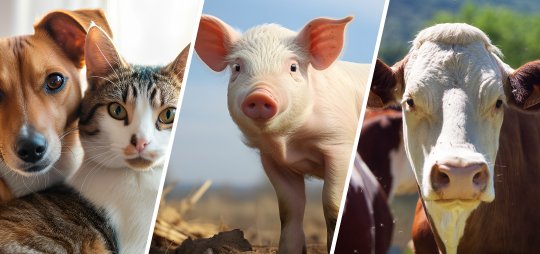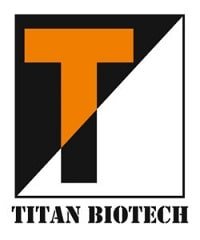Table of Content
- Understanding Protein Hydrolysate
- Benefits of Protein Hydrolysate in Animal Nutrition
- Various Sources of Protein Hydrolysate for Animal Feed
- Applications of Protein Hydrolysate in Animal Nutrition
- Which Animals Can Utilize Protein Hydrolysate?
- Conclusion
- About Titan Biotech Limited
- References
According to Global Market Insight’s report, the Animal feed protein hydrolysate market will grow at a CAGR of 6% between 2023 and 2032, valued at USD 659.4 Mn in 2023. The growth factors are the increasing demand for top-quality protein supplements and the increased nutritional content of formulations. Moreover, protein hydrolysates are derived from various sources, such as animal, plant, fish, and milk proteins.
Protein hydrolysates have emerged as a cornerstone in modern animal nutrition, revolutionizing how we optimize animal health and performance. Derived from various protein sources and processed to break down complex proteins into simpler forms, protein hydrolysates offer many benefits for animals across different stages of life and production. This blog delves into the basics of protein hydrolysates, their role in animal nutrition, and their uses in different animals.
Understanding Protein Hydrolysate
Protein hydrolysates are enzymatically or chemically processed proteins that undergo hydrolysis, breaking large protein molecules into smaller peptides and amino acids. This process enhances the digestibility and bioavailability of proteins, facilitating easier absorption and utilisation. Protein hydrolysates can be sourced from a diverse array of raw materials, including animal by-products, plant proteins, and marine sources, each offering a unique nutritional profile and functional properties.
Benefits of Protein Hydrolysate in Animal Nutrition
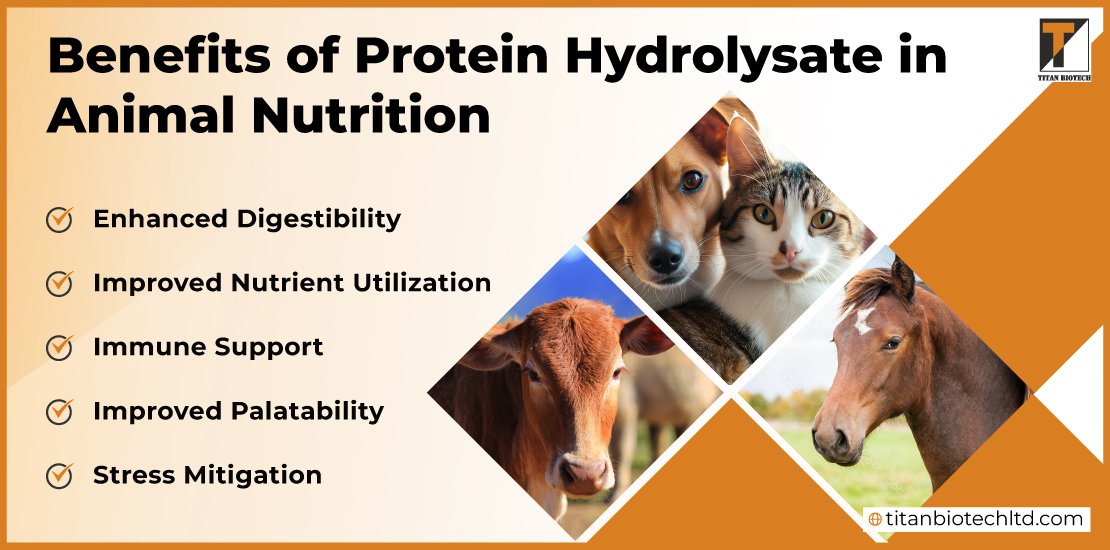
The increasing awareness among aquaculture and livestock farmers of the health advantages of protein hydrolysate drives the market growth. Some of the advantages are discussed below:
-
Enhanced Digestibility
The enzymatic breakdown of proteins into smaller peptides and amino acids increases the digestibility of protein hydrolysates, ensuring efficient nutrient absorption in the gastrointestinal tract of animals. This is particularly beneficial for young animals with developing digestive systems and older animals with decreased digestive capacity.
-
Improved Nutrient Utilization
Protein hydrolysates are readily available sources of essential amino acids, the building blocks of proteins. These amino acids are crucial for animal muscle development, immune function, and overall growth. Protein hydrolysates promote optimal nutrient utilization and metabolic efficiency as the amino acids are in the pre-digested form.
-
Immune Support
Certain protein hydrolysates contain bioactive peptides with immunomodulatory properties, bolstering the immune response and enhancing animal disease resistance. These peptides exert anti-inflammatory, antimicrobial, and antioxidant effects, contributing to overall health and reducing the incidence of infections in livestock, pets and other companion animals.
-
Palatability and Feed Intake
Protein hydrolysates can enhance the palatability of feed formulations, enticing animals to consume their feed more readily. It is advantageous when animals exhibit reduced appetite due to stress, illness, or environmental factors. Protein hydrolysates help maintain optimal nutrient intake and support animal performance by improving feed intake.
-
Stress Mitigation
With physiological or environmental stress, such as weaning, transportation, or disease challenges, animals may experience nutrient absorption and metabolism disruptions. Protein hydrolysates offer a source of easily digestible nutrients that help to reduce the negative effects of stress, promoting faster recovery and minimizing performance losses.
Various Sources of Protein Hydrolysate for Animal Feed
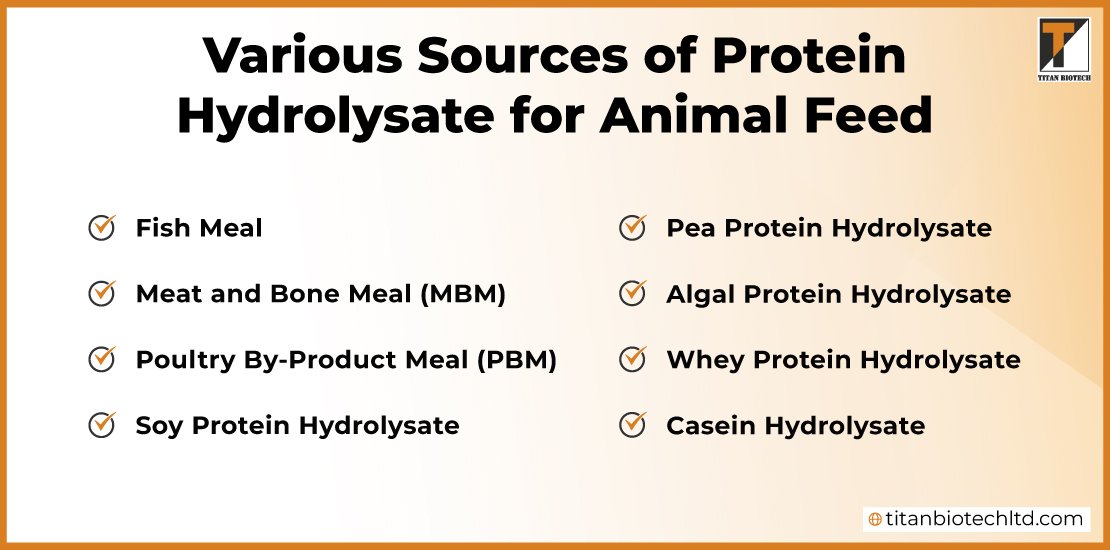
Protein hydrolysates for animal nutrition can be derived from plant and animal-based sources. Here are some common sources that are mentioned below:
- Fish Meal– A high-quality source of protein, fish meal is commonly used in aquaculture feeds. It is obtained by cooking, pressing, drying, and grinding whole fish or trimmings.
- Meat and Bone Meal (MBM)- Produced from animal by-products, MBM is a good source of protein and minerals. It is made by rendering slaughterhouse waste such as bones and blood.
- Poultry By-Product Meal (PBM)- PBM is made from processing poultry by-products like feathers, heads, feet, and viscera. It is rich in protein and minerals.
- Soy Protein Hydrolysate– Derived from soybeans, hydrolysate is created through enzymatic or acid hydrolysis, breaking down proteins into smaller peptides and amino acids. It’s commonly used in livestock and aqua feed.
- Whey Protein Hydrolysate– Whey, a by-product of cheese production, contains high-quality protein. Whey protein hydrolysate is created by enzymatic hydrolysis of whey protein, making it easier for digestion.
- Casein Hydrolysate– Casein, a protein found in milk, can be hydrolysed to create casein hydrolysate. It’s often used in milk replacers for young animals.
- Pea Protein Hydrolysate– Pea protein hydrolysate is derived from yellow peas and is gaining popularity in animal nutrition due to its nutritional profile and sustainable sourcing.
- Algal Protein Hydrolysate– Algal hydrolysate is gaining attention due to the rise of alternative protein sources. Algae are rich in protein, which is hydrolysed to improve digestibility.
These sources provide a range of options for formulating animal feeds with balanced nutrition and high digestibility. The choice of protein hydrolysate depends on factors such as the target animal species, nutritional requirements, cost, and availability.
Applications of Protein Hydrolysate in Animal Nutrition
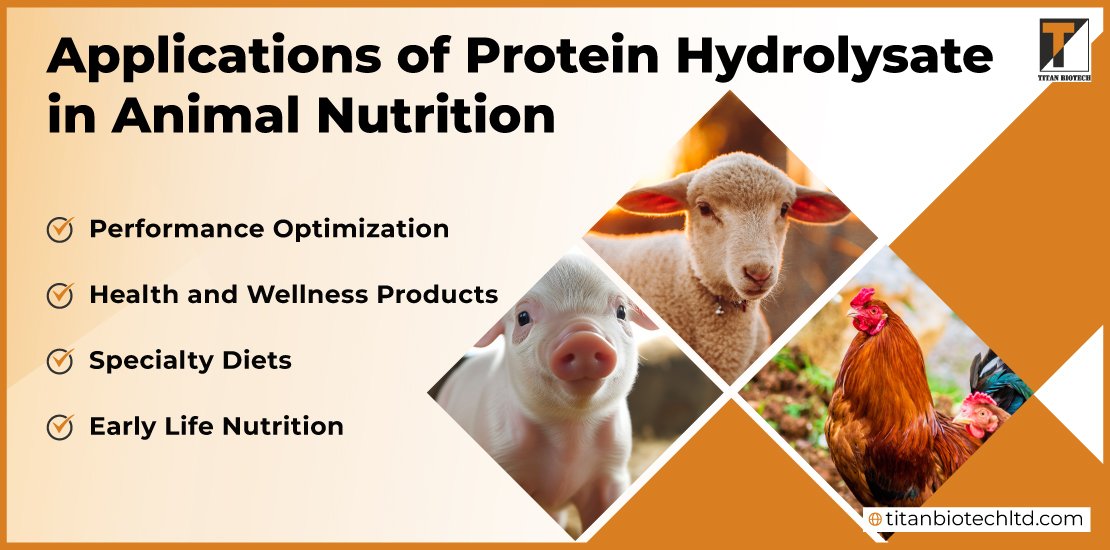
- Early Life Nutrition
Protein hydrolysates are commonly incorporated into milk replacers and starter feeds for young animals, including calves, piglets, and chicks. These formulations provide easily digestible proteins and essential nutrients for growth and development during the critical early stages of life.
- Specialty Diets
Protein hydrolysates are utilized in special diets for animals with specific nutritional requirements or health conditions. This includes diets for animals with food allergies, gastrointestinal disorders, or metabolic imbalances, where easily digestible proteins are essential for optimal nutrient utilization and digestive health.
- Performance Optimization
Protein hydrolysates are incorporated into feed formulations to optimize animal performance and productivity. Whether improving feed conversion efficiency in broilers, maximizing milk production in dairy cows, or enhancing reproductive performance in cows, protein hydrolysates play a vital role in meeting the nutritional demands of high-performing animals.
- Health and Wellness Products
Protein hydrolysates are also utilized to formulate health and wellness products for companion animals, including pet food, supplements, and treats. These products offer functional benefits such as joint support, skin and coat health, and overall vitality, catering to pet owners seeking premium nutrition for their beloved companions.
Which Animals Can Utilize Protein Hydrolysate?

Protein hydrolysate powder can potentially be used as a protein source for various animals, including:
- Poultry
Poultry, including chickens and turkeys, can benefit from protein hydrolysate powder as a source of easily digestible protein. This aids in muscle development, egg production, and overall growth.
- Swine
Pigs find protein hydrolysate powder advantageous for promoting lean muscle growth, enhancing reproductive performance, and supporting immune function, contributing to overall health and productivity.
- Pets
Pets, like dogs and cats, can utilize protein hydrolysate powder to meet their protein requirements, supporting muscle maintenance, energy levels, and overall vitality, which is particularly beneficial for ageing animals or those with specific dietary needs.
- Cattle
Cattle can incorporate protein hydrolysate powder into their diets to enhance growth, milk production in dairy cows, and reproductive performance, providing essential amino acids necessary for optimal health and productivity.
- Aquaculture
Aquaculture species, such as fish and shrimp, can benefit from protein hydrolysate powder as a high-quality protein source, supporting growth, immune function, and disease resistance, contributing to sustainable aquaculture practices.
- Equine
Horses can utilize protein hydrolysate powder to support muscle development, athletic performance, and overall health, providing essential amino acids for the growth, repair, and maintenance of body tissues, particularly valuable for performance and working horses.
- Ruminants
Ruminants like sheep and goats can incorporate protein hydrolysate powder into their diets to support growth, milk production in dairy animals, and reproductive performance, supplying essential amino acids for rumen fermentation and overall metabolic functions.
Conclusion
Protein hydrolysates, derived from the enzymatic breakdown of proteins into smaller peptides and amino acids, have gained attention as valuable ingredients in animal feed formulations. These hydrolysates offer several benefits in enhancing animal diets’ nutritional quality and performance. Due to their pre-digested nature, animal protein hydrolysates are easily absorbed and utilized, promoting efficient growth, development, and overall health. They provide a readily available source of essential amino acids, which are crucial for muscle development, immune function, and various metabolic processes.
Protein hydrolysates improve feed palatability, digestibility, and stability. Using them in animal feed can reduce feed costs, allowing for better utilization of dietary protein resources and decreasing the need for expensive protein supplements. Furthermore, protein hydrolysates have been shown to positively impact gut health and microbiota composition in animals, potentially reducing the incidence of digestive disorders and improving feed conversion efficiency. Protein hydrolysates are promising for optimizing animal nutrition and enhancing production efficiency in various livestock and aquaculture species.
About Titan Biotech Limited
Titan Biotech, based in Delhi, India, specializes in supplying top-quality raw materials to diverse industries such as Animal Nutrition, pharmaceuticals, nutraceuticals, cosmeceuticals, and the food and beverage sector. Renowned for our premium offerings, we are prominent manufacturers and exporters of Protein hydrolysate, collagen peptides, proteins, ox bile extract, yeast extract, bone and joint & skincare ingredients, and more, catering to various essential applications.
Leveraging our technical proficiency, we ensure our customers receive superior products and services. Our robust market presence enables us to stay abreast of local trends, fostering collaborations with key players across the globe.
With cutting-edge manufacturing facilities in Bhiwadi, Rajasthan, we adhere to stringent international quality standards throughout our production processes, including ISO and GMP. If you require Protein hydrolysate for Animal Feed, call or contact us. Our technical support team will provide the solution to meet your requirements.
References
- https://www.gminsights.com/industry-analysis/protein-hydrolysate-for-animal-feed-application-market
- https://www.researchgate.net/publication/314294437_Protein_hydrolysates_in_animal_nutrition_Industrial_production_bioactive_peptides_and_functional_significance
- https://pubmed.ncbi.nlm.nih.gov/34928369/
- https://www.frontiersin.org/articles/10.3389/fvets.2024.1360939/full
- https://www.sciencedirect.com/science/article/pii/S2352513419301723
- https://onlinelibrary.wiley.com/doi/abs/10.1111/are.15990
